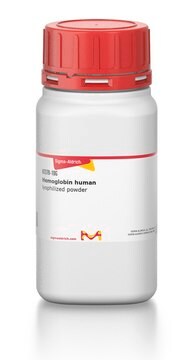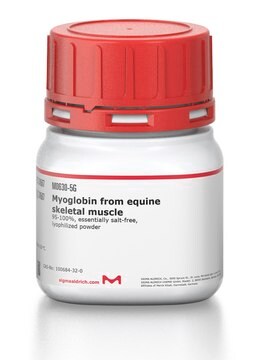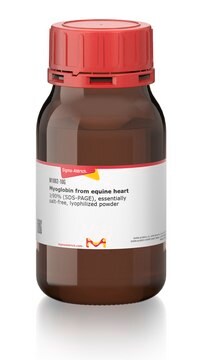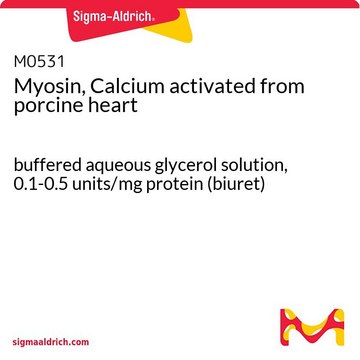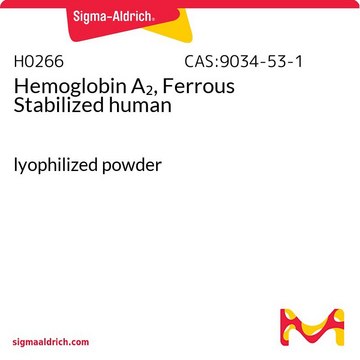Wszystkie zdjęcia(1)
Key Documents
H4632
Hemoglobin equine
lyophilized powder
Synonim(y):
Hb
Zaloguj sięWyświetlanie cen organizacyjnych i kontraktowych
About This Item
Polecane produkty
pochodzenie biologiczne
horse
Poziom jakości
Postać
lyophilized powder
metody
protein quantification: suitable
rozpuszczalność
H2O: soluble 10 mg/mL
temp. przechowywania
2-8°C
informacje o genach
horse ... HBA(100036557) , HBB(100054109)
Opis ogólny
Hemoglobin is the major component of red blood cells and is responsible for their red color. Its normal concentration in erythrocytes is 34%. The structure of horse hemoglobin was elucidated first. It comprises heme (iron protoporphyrin IX group) and four polypeptide chains. The fetal and adult hemoglobin of horse are structurally identical.
Zastosowanie
Hemoglobin equine has been used as a standard protein:
- to test solid-film sampling methodology in Fourier transform infrared spectroscopy (FT-IR) for protein secondary structure determination
- in capillary reversed-phase liquid chromatography-tandem mass spectrometry (LC/MS/MS) post enzymatic digestion
- for quantification of hemoglobin content from the planktonic crustacean, Daphnia magna
Działania biochem./fizjol.
Hemoglobin is the most important respiratory protein of vertebrates by its ability to transport oxygen from the lungs to body tissues and to facilitate the return transport of carbon dioxide. The ferrous-ferric (Fe2+/Fe3+) balance is a physiological indicator of blood oxygenation. Deoxygenated hemoglobin accessorizes a feedback loop by reducing nitrite to nitric oxide (NO), a vasodilator which enhances blood flow to oxygen-deprived tissues. The fetal and adult hemoglobin from horse display differences in their affinity towards 2,3-diphosphoglycerate (2,3-DPG). Mutation in the globin gene is implicated in sickle cell anemia.
Oxygen transporter, NO scavenger
Przestroga
Since native hemoglobin is readily oxidized in air, these preparations may be predominantly methemoglobin.
This page may contain text that has been machine translated.
Zastosowanie
Numer produktu
Opis
Cennik
Kod klasy składowania
11 - Combustible Solids
Klasa zagrożenia wodnego (WGK)
WGK 3
Temperatura zapłonu (°F)
Not applicable
Temperatura zapłonu (°C)
Not applicable
Środki ochrony indywidualnej
Eyeshields, Gloves, type N95 (US)
Certyfikaty analizy (CoA)
Poszukaj Certyfikaty analizy (CoA), wpisując numer partii/serii produktów. Numery serii i partii można znaleźć na etykiecie produktu po słowach „seria” lub „partia”.
Masz już ten produkt?
Dokumenty związane z niedawno zakupionymi produktami zostały zamieszczone w Bibliotece dokumentów.
Klienci oglądali również te produkty
Pavel V Bondarenko et al.
Analytical chemistry, 74(18), 4741-4749 (2002-09-28)
In this report, we describe an approach for identification and relative quantitation of individual proteins within mixtures using LC/MS/MS analysis of protein digests. First, the proteins are automatically identified by correlating the tandem mass spectra with peptide sequences from a
A comparative study on STM imaging and electrocatalytic activity of different surfaces modified with flavin adenine dinucleotide
Jingdong Zhang, Qijin Chi, Erkang Wang, Shaojun Dong
Electrochimica Acta, 40, 733-744 (1995)
Alan N Schechter
Blood, 112(10), 3927-3938 (2008-11-08)
Much of our understanding of human physiology, and of many aspects of pathology, has its antecedents in laboratory and clinical studies of hemoglobin. Over the last century, knowledge of the genetics, functions, and diseases of the hemoglobin proteins has been
Alain J Marengo-Rowe
Proceedings (Baylor University. Medical Center), 19(3), 239-245 (2007-01-26)
In 1949 Pauling and his associates showed that sickle cell hemoglobin (HbS) belonged to an abnormal molecular species. In 1958 Ingram, who used a two-dimensional system of electrophoresis and chromatography to break down the hemoglobin molecule into a mixture of
Yan Zhang et al.
Zoological science, 20(9), 1087-1093 (2003-10-28)
The physiological significance of the position and shape of the oxygen equilibrium curve (OEC) of horse hemoglobin (Hb) is considered from the viewpoint of oxygen (O2) transport efficiency and the effectiveness of the Bohr effect. In horse fetal and maternal
Nasz zespół naukowców ma doświadczenie we wszystkich obszarach badań, w tym w naukach przyrodniczych, materiałoznawstwie, syntezie chemicznej, chromatografii, analityce i wielu innych dziedzinach.
Skontaktuj się z zespołem ds. pomocy technicznej